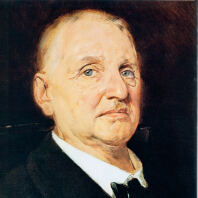Anton Bruckner
Compositeur
Anton Bruckner est, avec Johannes Brahms, le symphoniste germanophone le plus important de la seconde moitié du XIXe siècle. L’un comme l’autre s’en sont tenus au modèle classique de la symphonie en quatre mouvements. Du fait de son ardente foi catholique, les symphonies monumentales de Bruckner étaient déjà comparées de son vivant à des « cathédrales » sonores. La presse musicale le rangea par ailleurs – sans lui demander son avis – dans le clan progressiste de Richard Wagner, auquel s’opposait le clan conservateur de Brahms. Le fait est que Bruckner vénérait ouvertement Wagner : il lui a dédié sa Troisième Symphonie, et l’Adagio de la Septième est généralement considéré comme une musique funèbre pour celui que Bruckner appelait le « maître décédé, bien-aimé, immortel ».
Né en 1824 près de Linz, Anton Bruckner est le fils d’un maître d’école et commence lui aussi par exercer le métier d’enseignant. Parallèlement à ses activités d’instituteur à l’abbaye de Saint-Florian et d’organiste de la cathédrale de Linz, il se forme à la théorie musicale. Après avoir brillamment réussi l’examen du conservatoire de musique, Bruckner poursuit ses études et ne se présente que tardivement au public comme compositeur : la création de sa Symphonie n° 1 a lieu quand Bruckner a 41 ans. De 1868 à sa mort, il vit à Vienne sans toutefois obtenir pendant longtemps la reconnaissance qu’il mérite. La plupart des neuf symphonies cataloguées de Bruckner existent en plusieurs versions. Perfectionniste, le compositeur pouvait consacrer plusieurs années à remanier une œuvre. Ces différentes versions nous renseignent sur le travail d’un artiste qui a marqué l’histoire du genre symphonique. Inachevée et harmoniquement audacieuse, sa Neuvième préfigure la modernité musicale. Si Hans von Bülow, le premier chef principal des Berliner Philharmoniker, garda ses distances envers Bruckner, son successeur Arthur Nikisch fit entrer sa musique au répertoire de l’orchestre.